Difference analysis in terahertz wave propagation in thermochemical nonequilibrium plasma sheath under different hypersonic vehicle shapes
Wenchong OUYANG, Qi LIU, Zhengwei WU,c,*
a School of Nuclear Science and Technology, University of Science and Technology of China, Hefei 230026, China
b Joint Laboratory of Plasma Application Technology, Institute of Advanced Technology, University of Science and Technology of China, Hefei 230031, China
c CAS Key Laboratory of Geospace Environment, University of Science and Technology of China, Hefei 230026, China
KEYWORDS
Abstract Research on terahertz communication under different vehicles has important guiding significance for the design of future hypersonic vehicle and Radio Frequency (RF) blackout.In this paper,a joint simulation model of plasma flow under thermochemical nonequilibrium state and terahertz transmission is developed to investigate the differences in terahertz wave transmission characteristics under different vehicle shapes and the related mechanisms.By comparing the plasma sheath characteristics and terahertz transmission among HIFIRE-5b (Hypersonic International Flight Research Experimentation-5b), RAM C(Radio Attenuation Measurement C) and ARD(Atmospheric Reentry Demonstrator) vehicles, it is found that the sheath thickness and electron density of ARD vehicles is significantly larger than that of HIFIRE-5b and RAM C vehicles,resulting in greater terahertz wave attenuation.Collision absorption plays a major role in the terahertz attenuation of vehicles,and the contribution of reflection effects is only observed in the ARD vehicle due to its larger plasma sheath thickness and spatial structure variation.Based on the above comparison results, a shape design scheme of reducing the vehicle head and tail for mitigating RF blackout is proposed,and the scheme is proved by further analyzing the effects of different vehicle heads and tails on the terahertz communication.With the decrease of the head radius and tail width of hypersonic vehicle,the wave attenuation at the same terahertz frequency decreases,and the contribution of reflection effect to wave attenuation gradually disappears.Therefore, the shape design scheme of reducing the vehicle head and tail can effectively alleviate the RF blackout problem, which provides an important reference value for future hypersonic vehicle design.
1.Introduction
During spacecraft reentry mission, the neutral gas undergoes nonequilibrium chemical reactions such as ionization and recombination due to the effect of high speed and high temperature, thereby forming a plasma sheath covering the vehicle surface.1Relevant research results show that the electron density in the reentry plasma sheath can reach up to 1021m-3,and the corresponding cutoff frequency is 0.28 THz.2Electromagnetic Waves (EMW) encounter severe reflection and absorption effects through dense plasma sheaths, especially when EMW frequency is lower than the plasma cutoff frequency,and the Radio Frequency (RF) blackout phenomenon occurs.3 RF blackout problem has been observed in various space exploration missions such as the lunar sample return missions and hypersonic vehicle reentry experiment,4,5which poses a serious threat to the vehicle safety and has always been one of the difficult problems to be solved urgently in aerospace field.6
Researchers have carried out extensive efforts to solve the RF blackout problem,and some theoretical methods have been proposed, such as terahertz communication,7vehicle shape optimization,8surface catalysis effect,9,10magnetic window,11etc.With the rapid development of terahertz sources, terahertz communication scheme is considered as a potential solution with engineering feasibility to solve the RF blackout due to its high frequency and broadband characteristics.12,13Related theoretical and experimental studies have shown that terahertz waves can effectively penetrate dense plasma sheaths, and found that the plasma parameters such as electron density,collision frequency and plasma thickness are the main factors affecting terahertz transmission.14,15Furthermore, a coupled model of flow field and electromagnetic calculation16–21is developed to explore the relationship between flight parameters and plasma sheath and reentry communication.Recent studies have reported that flight conditions such as flight speed,atmospheric environment and angle of attack can significantly alter the plasma sheath characteristics,which in turn affect the interaction between terahertz wave and plasma sheath.18–21
Although the terahertz transmission characteristics in plasma sheaths of RAM C (Radio Attenuation Measurement C) vehicle have been systematically studied, the effects of different vehicle shapes on the plasma sheath characteristics and terahertz communication have rarely been paid attention to.In 2021, Tang et al.have reported that the differences in the spatial structure of plasma sheaths and terahertz transmission of blunt-coned and sharp-coned vehicles have been reported.22However, the sharp-coned vehicle is only constructed from the RAM C vehicle variant,which does not correspond to the structure and size of the real vehicle.Furthermore, the vehicle types need to be further increased for a comprehensive comparison,in order to explore the design scheme of future hypersonic vehicle for encountering lighter blackout problem.In addition, most of the above studies on the interaction between terahertz waves and reentry plasma sheaths only consider chemical nonequilibrium (that is, the translation, rotation, vibration and electron temperatures are described by the same temperature)18–23and ignore the influence of thermochemical nonequilibrium.
Therefore, characteristics of terahertz wave propagation in thermochemical nonequilibrium plasma sheath under three typical real hypersonic vehicles represented by RAM C(blunt-coned),24HIFIRE-5b(Hypersonic International Flight Research Experimentation-5b) (sharp-coned)25and ARD(Atmospheric Reentry Demonstrator)vehicles(complex structure)26are focused in this paper, and the configuration of three vehicles is shown in Fig.1.In Fig.1,L represents the distance from the surface antenna of vehicle.Firstly, plasma sheath characteristics under thermochemical nonequilibrium state are obtained by solving the expanded Navier-Stokes(N-S) governing equations based on the CFD method.Thermal nonequilibrium and chemical nonequilibrium states are described by two-temperature model and 7-species 18-chemical-reaction model.Thermal nonequilibrium and chemical nonequilibrium phenomenon around hypersonic vehicle is observed and discussed, and differences in the plasma sheath characteristics under different vehicle shapes are compared.Secondly, the differences in propagation characteristics of terahertz wave under different vehicle shapes are analyzed by scattering matrix method based on the plasma sheath distribution,and the related mechanisms that cause the differences are discussed.Finally,a shape design scheme of future hypersonic vehicle for encountering lighter blackout problem is proposed,and the proposed scheme is theoretically verified by the above joint simulation model of hypersonic plasma flow and terahertz wave transmission.
The remainder of this paper is organized as follows.In Section 2,the numerical method of hypersonic plasma flow under thermochemical nonequilibrium is described, and accuracy of model algorithm is verified based on the flight test data.27Terahertz wave transmission model and the joint simulation process with plasma sheath are introduced in detail in Section 3.In Section 4, results are obtained by the joint simulation of hypersonic plasma flow under thermochemical nonequilibrium and terahertz wave transmission model.The conclusions are drawn in Section 5.
2.Hypersonic plasma flow model under thermochemical nonequilibrium
The reentry plasma sheath characteristics of HIFIRE-5b,RAM C and ARD vehicles are obtained by solving plasma flow model considering thermochemical nonequilibrium,which adds thermal nonequilibrium based on the plasma flow model developed in our previous study.10,24The hypersonic plasma flow model under thermochemical nonequilibrium consists of the governing equations, thermal nonequilibrium model, chemical nonequilibrium model, and transport model,and the plasma flow around hypersonic vehicles is assumed to be stable, compressible, laminar in nonequilibrium state.
2.1.Governing equations
The flow field around hypersonic vehicles can be described by the N-S governing equations, and its two-dimensional form is expressed as
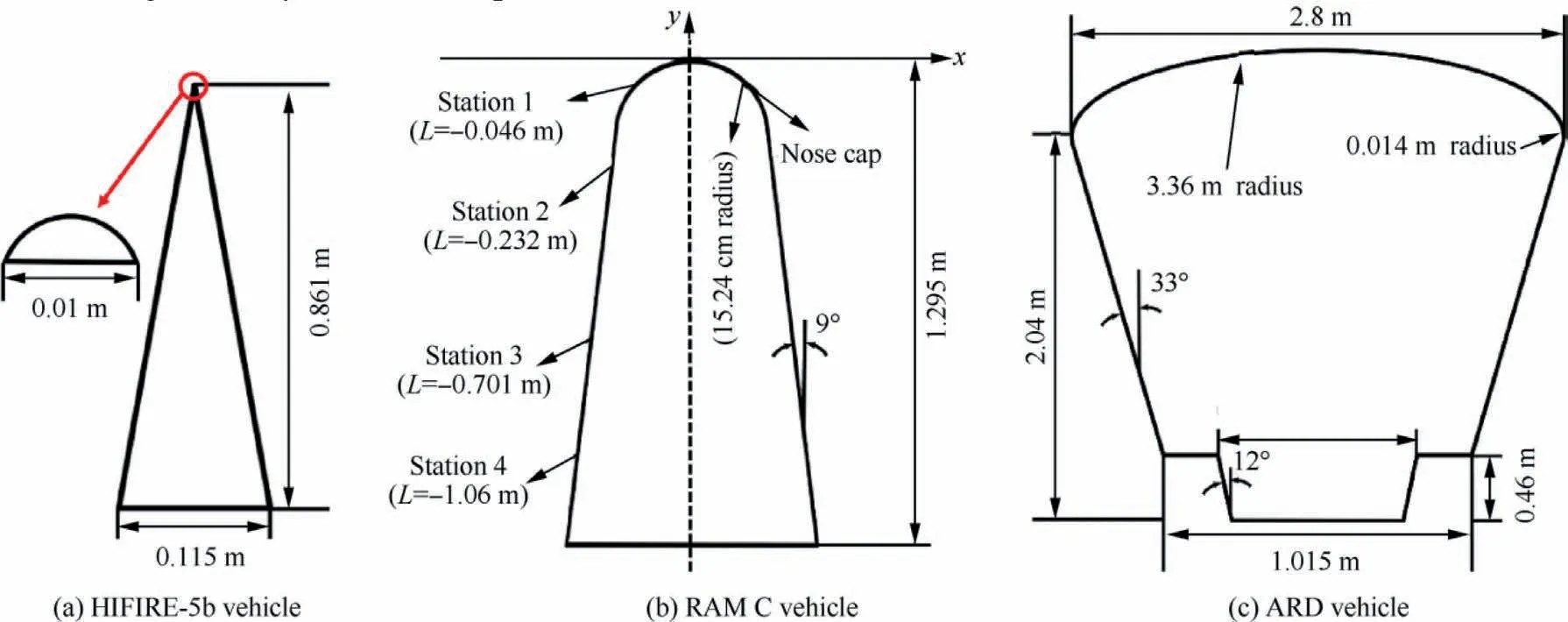
Fig.1 Configuration of HIFIRE-5b, RAM C and ARD vehicles.
where Q refers to the conservative vector, F and G represent the convective flux vector,Fvand Gvrepresent the viscous flux vector, and W refers to the source term due to the thermal nonequilibrium and chemical nonequilibrium.Park’s twotemperature model considering translational-rotational and vibrational-electron temperature28is used to describe the thermal nonequilibrium.Chemical nonequilibrium is expressed by using seven-species (N2, O2, NO, N, O, NO+, e) eighteenchemical-reaction model, and the seven species all satisfy the mass conservation laws.Therefore, the expanded form of Eq.(1) is expressed as
where ρ and ρsrepresent the density of all mixed species and each species, respectively; u and v are the fluid velocity in the x-direction and y-direction, respectively; E and Eele+vibrefer to the total energy, vibrational and electron energy; p and pelerepresent the total pressure and electron pressure, respectively; τ, J and q represent the stress tensor, diffusion flux and heat flux, respectively; H refers to the enthalpy flux due to diffusive transfer;w∙s and S represent the change rate of species density and internal energy exchange, respectively.
The above N-S governing equations consist of twelve differential equations, which satisfy the mass conservation (the first equation), momentum conservation (the second and the third equations), total energy conservation (the fourth equation),mass conservation of each species (the fifth to the eleventh equations),and electron energy conservation(the twelfth equation), respectively.
N-S governing equations can be solved by coupling thermal nonequilibrium model, chemical nonequilibrium model, and transport model.Parameters such as p, pele, E, Eele+viband S are solved by thermal nonequilibrium model.Source termis calculated by chemical nonequilibrium model.Stress tensor τ, diffusion flux J and heat flux q are obtained by transport model.
In this paper,the finite volume method is applied to numerically solve the N-S governing equations based on the USim code.The principle is to discretize partial differential equations into difference equations through the Runge-Kutta method.In addition,MUSCL limiters are used to eliminate spurious oscillation problems to obtain numerical solutions with high order accuracy.
2.2.Thermal nonequilibrium model
The thermal nonequilibrium in this paper is realized by using park’s two-temperature model.28That is, the translational temperature Ttrsand the rotational temperature Trotare described by the same temperature(Ttrs=Trot),and the vibrational temperature Tviband the electronic temperature Teleare represented by another same temperature (Tvib=Tele).
The total pressure of the air mixture is calculated using Dalton’s law of partial pressures:
where ph, Rcand M represent the heavy particle pressure, gas constant and molar mass, respectively.
The total energy is composed of translational and rotational energy Etrs+rot, vibrational and electron energy Eele,kinetic energy Ekin, and enthalpy energy of formation Een.
where
where Θvib,srefers to vibrational characteristic temperatures;Δhf,srefers to the formation enthalpy of s species, which can be obtained from Table I and Table II in Ref.29.
In the N-S governing equations under the two-temperature model, the energy relaxation effect existing among the constituent particles will lead to the fact that the exchange rate of internal energy Seleis caused by the energy relaxation process of translational energy and vibrational energy mode STV, translational energy and electron energy mode STE, and the change rate in vibrational energy due to changes in species density due to chemical reactions SCV.28–31
2.3.Chemical nonequilibrium model
The shock wave occurs in the nose of hypersonic vehicle due to the ultra-high reentry velocity (well above Mach number 5),and is accompanied by complex chemical nonequilibrium effect.The chemical nonequilibrium effect in the formation of the plasma sheath is reflected in the change rate of species density, that is, the source term w∙s in Eq.(4).In this paper,7-species 18-chemical-nonequilibrium-reaction model(Table 1)is used to solve the source term
The entire chemical nonequilibrium system consists of ns chemical components and nr reversible chemical reactions(ns = 7,nr = 18), and then the rth chemical reaction of the system can be expressed as
where r=1,2,∙∙∙,nr and s=1,2,∙∙∙,ns;αrsand α*rsrepresent the forward and backward reaction coefficients.Therefore,the generated source term for the rth reaction is expressed as
The change rate of species densitycan be obtained according to the source term for the ith reaction
where kfrand kbrrepresent the forward reaction rate and backward reaction rate of reaction r,respectively,which can be calculated by
where Ac, n′, Earepresent the forward reaction rate factor,temperature index, and activation energy, respectively; Bcand cirefer to the backward reaction rate factor, which can be obtained by Table 1;Kerrefers to the equilibrium constant;Tfrand Tbrrepresent the effective temperatures of the forward reaction and backward reaction.
2.4.Transport model
The plasma transport process under thermochemical nonequilibrium effect includes the viscous effect between fluids,the diffusion source term caused by the difference in the spatial distribution of the concentration of each component, and the heat transfer phenomenon caused by the difference in the spatial temperature distribution.The transport coefficients involved in these transport processes are viscosity coefficient,thermal conductivity coefficient and diffusion coefficient.
(1) Viscosity: The stress tensor terms τ in two dimensions contain τxx, τyy, τxyand τyx, which are expressed as
where μ refers to the dynamic viscosity coefficient, which can be solved by the curve fitting method of park and Gupta28,30,31combining the Wilke’s mixing law formula.32
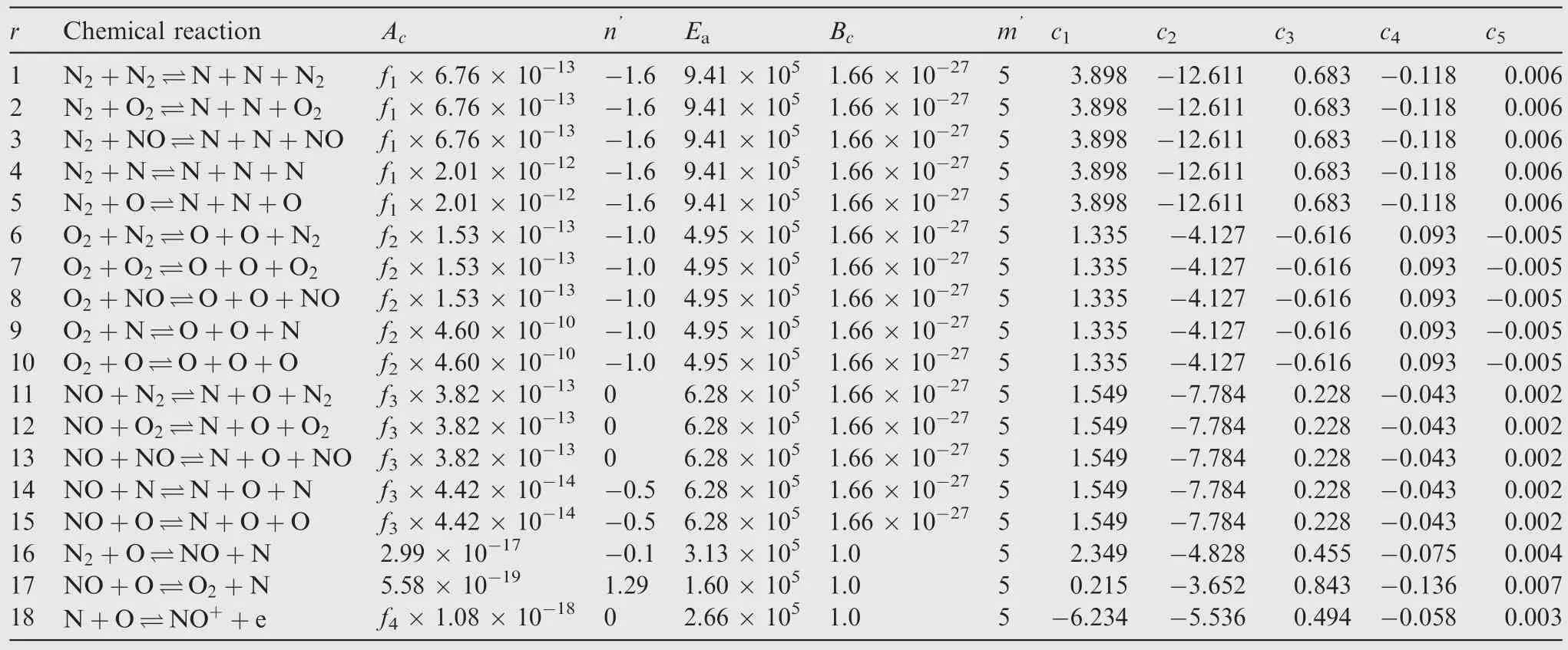
Table 1 Chemical reactions and reaction coefficients.
where Aμs, Bμs, Cμs, Dμs, and Eμsare all coefficients obtained from the fitting curve.
(2) Thermal conductivity: The heat flux q is expressed as
where λtrs, λrot, λviband λelerepresent the thermal conductivity coefficient of translational mode, rotational mode, vibrational mode and electronic mode, which can be obtained from Ref.31.
(3) Diffusion: The diffusion flux J is expressed as
where XSis the mole fraction of species s.Dsrefers to the effective diffusion coefficient, which can be calculated as
where Screfers to the Schmidt number.For the molecules and atoms,Sc=0.5.For the ions,Sc=0.25.Under plasma quasineutral conditions, the electron diffusion coefficient Deleis expressed as
2.5.Computational conditions and algorithm verification
Four sets of different numbers of grids are used to verify the sensitivity of the calculation results to changes in mesh density,as shown in Table 2.Since the RAM C vehicle has more detailed electron density data at 61 km, the plasma sheath characteristics in Section 2.5 focus on the four positions(L = -0.046, -0.232, -0.701, -1.060 m), as shown in Fig.1(b).Reentry altitude used for the algorithm verification of the three vehicles is set to 61 km, and the corresponding atmospheric density and temperature are 2.816 × 10-4kg/m-3and 244.3 K, respectively.The flight speed is 7650 m/s,and the angle of attack is 0°.
Fig.2 shows the effect of four sets of different grids on the calculation results of electron density under RAM C,HIFIRE-5b and ARD vehicles.Obviously, with the increase in the number and quality of grids from Grid 1 to Grid 4,the results of the electron densities of these three types of vehicles gradually tend to be stable, and the calculation results under Grid 3 hardly change.In addition, Fig.2compares the electron density results of thermochemical nonequilibrium model (two-temperature model) in this paper with the thermal equilibrium chemical nonequilibrium model(single-temperature model) in previous study10,24and flight test data27.There is little difference in the electron density results between the thermochemical nonequilibrium model and thermal equilibrium chemical nonequilibrium model,and the variation trend of maximum electron density along the axis (y) is almost the same.However, the electron density results of the thermochemical nonequilibrium model are closer to the flight data than thermal equilibrium chemical nonequilibrium model.Therefore, the calculation grids of the three vehicles in this paper all use Grid 4.

Table 2 Grid numbers for algorithm verification of different hypersonic vehicles.
Corresponding grid numbers and grid size distribution of Grid 4 are shown in Table 2 and Fig.3, respectively.Obviously, in order to capture the shock layer and reduce the amount of calculation as much as possible without affecting the calculation results, the grids of the calculation area near the aircraft head and the wall are set very dense,and the grids of other areas are relatively loose.
2.6.Analysis of thermal nonequilibrium and chemical nonequilibrium phenomenon
Figs.4(a)and(b)further show the distribution of translational temperature and electron temperature around RAM C vehicle,and the translational and electron temperatures reach peak values of approximately 14500 K and 9600 K, respectively.Compared with the thermal equilibrium and chemical nonequilibrium model, both the translational and electron temperatures are significantly lower than the temperature values (16700 K) in the single temperature model (Fig.5(b) in Ref.24).The reason is that the excited electron energy modes absorb translational energy.
Fig.5(a) further shows the comparison of specific translational and electron temperatures on the stagnation point line,and the stagnation point line is shown by the red dotted line in Fig.4(a).Thermal nonequilibrium and chemical nonequilibrium phenomenon can be observed in Fig.5(a)and(b),respectively.Due to the high reentry velocity of Mach 22.5 and the lower atmospheric density, a strong shock wave is formed in front of RAM C vehicle, and high temperature plasma is observed behind the shock wave.It can be found from Fig.5(a) that the translational temperature gradually increases due to the conversion of the kinetic energy of the free flow into thermal energy,reaching the maximum at the shock layer near the vehicle head (14500 K), and the position of maximum translational temperature(L=0.0155 m)is actually the inner wall of the shock wave.The relaxation process of the translational-electron energy leads to an increase in electron temperature and gradual decrease in translational temperature.In addition, it is obvious that the translational and electron temperature gradients are extremely large near the shock layer,which reveal a high degree of thermal nonequilibrium in the shock layer.
The change of the mass fraction of each component can be seen in Fig.5(b),which shows that N2and O2undergo a strong chemical nonequilibrium process when passing through the shock layer.Due to the high translational temperature, a strong chemical reaction of N2and O2occurs,so that the mass fraction of N2decreases by about 20% after passing through the shock wave and stabilizes in the sheath shock layer, and O2is almost completely consumed.In addition, only a small amount of O re-combine into O2when reaching the wall.On the other hand, N2and O combine to form NO, and the ionization reaction between N and O produces a small amount of NO+and e.These substances such as N2,O2,N,O,NO,NO+and e produced by the thermochemical nonequilibrium effect form the plasma sheath.
3.Terahertz wave transmission model and joint simulation process with plasma sheath
3.1.Terahertz wave transmission model
The multilayer transmission model method is applied to analyze the terahertz transmission characteristics and difference in the impact of flight speed on terahertz communication under different vehicle shapes.The scheme of multilayer transmission model is achieved by setting the plasma distribution near the antenna as the plasma plate and dividing the plasma plate into multiple uniform thin layers, as shown in Fig.6.

Fig.2 Grid independence verification of HIFIRE-5b, RAM C and ARD vehicles.

Fig.3 Grid distribution of Grid 4 of HIFIRE-5b, RAM C and ARD vehicles.

Fig.4 Distribution of translational and electron temperatures.
The signal transmitted by the antenna is received by the ground base station after passing through the reentry plasma sheath, so the signal receiving and transmitting ends are set to (I) Free space and (III) Free space, and the intermediate plasma environment is set to (II) re-entry plasma sheath.The terahertz wave enters the plasma sheath at a certain angle obliquely,is reflected and absorbed by the multi-layer plasma,and finally transmits through the plasma sheath.The transmission,reflection and absorption coefficients of terahertz waves can be solved globally by coupling the boundary conditions between each two adjacent layers.As shown in Fig.6, the re-entry plasma sheath is evenly divided into m layers, and the thickness of each layer is:
where Δd refers to the distance from the terahertz wave incident interface to the mth layer.
The plasma of each layer is regarded as a loss medium,and its corresponding relative permittivity εr(m ) is expressed as
where w represents the angular frequency of the terahertz wave, and wprepresents the plasma cutoff frequency, which is related to the electron density.
where ne,Qe,meand ε0represent the electron density,electron charge, electron mass, and vacuum permittivity, respectively.Electron density and collision frequency correspond to the plasma sheath data for each layer.
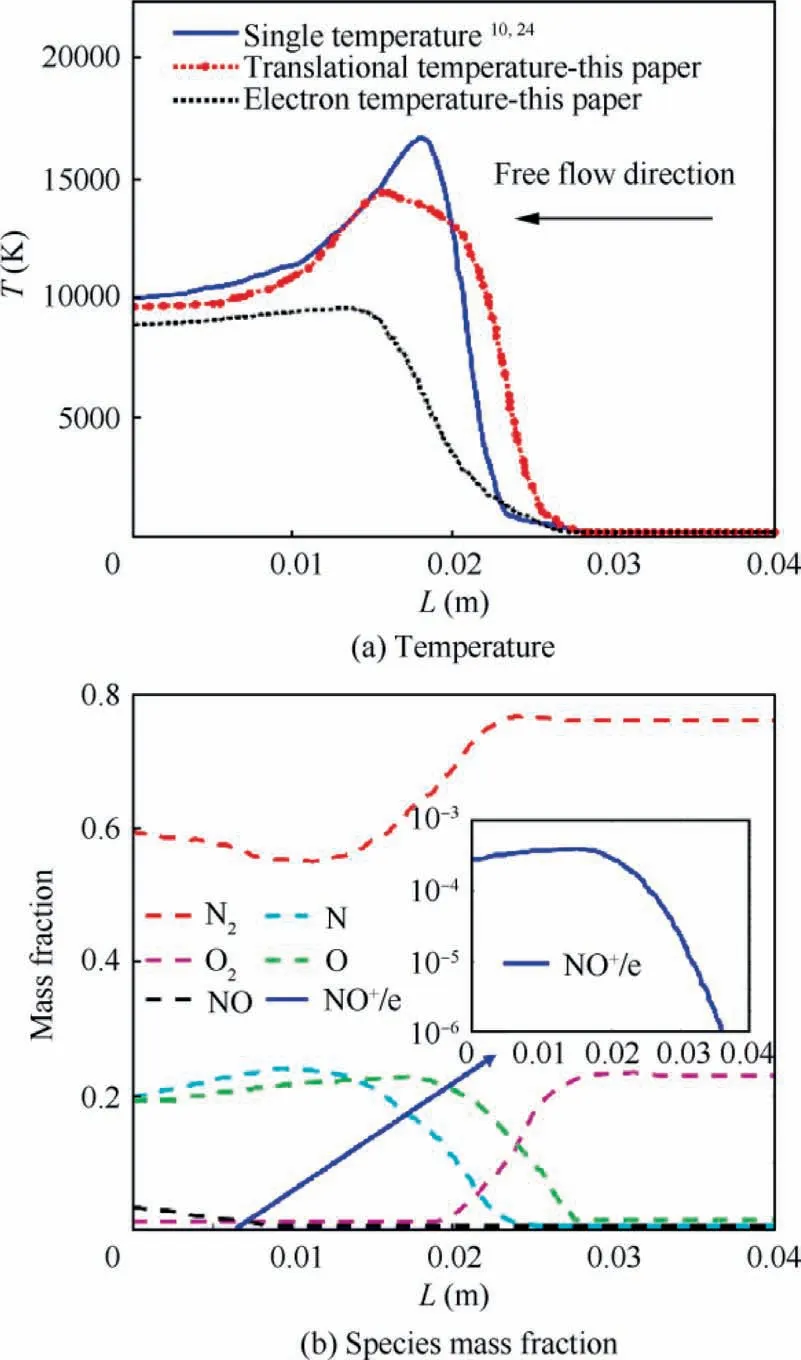
Fig.5 Distribution of temperature and species mass fraction on stagnation point line.
Therefore, the corresponding wavenumber of each layer can be determined according to the relative permittivity.
Transmission, reflection and absorption coefficients of terahertz waves are represented in matrix form.

Fig.6 Schematic diagram of multi-layer transmission model.Different colors correspond to different electron densities, and θi represents the incidence angle.
The scattering matrix Smof each layer is expressed as
where Qm-1can be solved as:
By coupling the EMW boundary conditions at the interface between adjacent layers, the transmission coefficient and reflection coefficients of terahertz waves and the global scattering matrix satisfy the following relationship:
where V is expressed as
The global transmission coefficient and reflection coefficient of terahertz waves can be obtained by Eq.(42).Absorption coefficient of terahertz waves can be solved by
Finally, the corresponding specific attenuation, reflection and absorption values (in dB) are solved by
where GTrepresents the attenuation value of terahertz wave,and the corresponding reflection and absorption values can be obtained by substituting R and A for T in Eq.(44).
3.2.Joint simulation process
Based on the hypersonic plasma flow model under thermochemical nonequilibrium and terahertz transmission model, a joint simulation model is developed to investigate the differences in the plasma sheath and terahertz transmission characteristics under RAM C, HIFIRE-5b and ARD vehicles.The specific joint simulation process is shown in Fig.7.
Firstly, the plasma sheath characteristics around RAM C,HIFIRE-5b and ARD vehicles are solved by the hypersonic plasma flow model under thermochemical nonequilibrium,and the electron density,collision frequency,and plasma thickness data can be obtained from the plasma distribution.Secondly, these data are used as the input of the terahertz transmission model, and the corresponding transmission,reflection and absorption coefficients are solved by the scattering matrix method and boundary electromagnetic condition matching of plasma layer.So far,the joint simulation of hypersonic plasma flow model and terahertz transmission model has been completed.
Based on the joint simulation of terahertz waves and plasma sheath, the differences in plasma sheath and terahertz transmission characteristics under different vehicle shapes are firstly analyzed, and the related mechanisms of this difference phenomenon are discussed.Finally, a shape design scheme of future hypersonic vehicle for encountering lighter blackout problem is proposed and theoretically verified.
4.Results and discussion
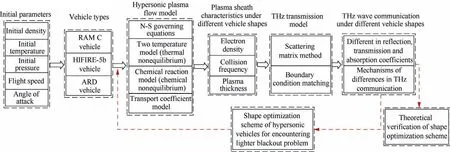
Fig.7 Joint simulation process of hypersonic plasma flow model and terahertz wave transmission model.
This section presents and discusses the numerical results.In Section 4.1, differences in parameter characteristics such as electron density, collision frequency, sheath thickness, and spatial structures of plasma sheath under different vehicle shapes are analyzed.In Section 4.2, differences in terahertz transmission characteristics under different vehicle shapes are analyzed, and related mechanism is discussed in Section 4.3.In Section 4.4, a shape optimization scheme of future hypersonic vehicle for encountering lighter blackout problem is proposed, and the proposed shape optimization scheme is theoretically verified by the joint simulation model of hypersonic plasma flow and terahertz wave transmission.
4.1.Difference in influence of flight speed on plasma sheath characteristics under different vehicle shapes
Signal communication during vehicle reentry mainly depends on plasma sheath parameters such as the electron density and collision frequency.Therefore,the plasma sheath distributions enveloping RAM C, HIFIRE-5b, and ARD vehicles are first solved by hypersonic plasma flow model under thermochemical nonequilibrium.In Section 2.5, this model has been verified by the grid independence and flight data comparison(Fig.2), and thermochemical nonequilibrium phenomenon around hypersonic vehicles is observed and discussed by comparing with thermal equilibrium and chemical nonequilibrium model(Figs.4 and 5).The specific configuration parameters of HIFIRE-5b, RAM C and ARD vehicles can be found in Fig.1.The initial parameters such as atmospheric environment and flight parameters corresponding to the three types of vehicles are the same.Reentry altitude is selected to be 31 km where RF blackout is the most serious, the corresponding atmospheric density and temperature are 1.8 × 10-2kg/m-3and 231.2 K respectively,2and the reentry speed and angle of attack are 6550 m/s and 0° respectively.
Fig.8 shows the distribution of plasma sheaths enveloping HIFIRE-5b,RAM C and ARD vehicles.It is obvious that the plasma sheaths enveloping different vehicles have significant differences, no matter in sheath thickness, spatial structure or specific value.Therefore, the terahertz wave transmission characteristics in the plasma sheaths enveloping the three types of vehicles will be different.Electron density, plasma sheath thickness and collision frequency are the most important factors affecting the attenuation of EMW communication, which are focused on in this paper.18,24

Fig.8 Distribution of electron density((a),(b),(c))and collision frequency ((d), (e), (f)) under different vehicle shapes.
According to Fig.8, the plasma sheath thickness, electron density, and collision frequency of ARD vehicle are significantly larger than those of the other two vehicles, and the plasma sheath thickness of HIFIRE-5b vehicle is slightly smaller than that of RAM C vehicle.In order to better compare the plasma sheath characteristics near antenna installation positions under different vehicles, Fig.9 shows the distribution of electron density and collision frequency on the terahertz wave transmission path.Since the size, shape and structure of HIFIRE-5b, RAM C and ARD vehicles are inconsistent,the antenna is selected in the middle position of vehicle(y = - 0.43 m for HIFIRE-5b vehicle, y = - 0.65 m for RAM C vehicle,y= -1.02 m for ARD vehicle),and the terahertz wave transmission path corresponding to the antenna position is shown by the white dotted line in Fig.8.
According to Fig.9, plasma sheath thickness of HIFIRE-5b, RAM C and ARD vehicles are 0.05 m, 0.2 m and 2.0 m,respectively, which are consistent with the results of previous studies.2,22,26Surprisingly, the plasma sheath thickness of ARD and RAM C vehicles is about 40 times and 10 times that of HIFIRE-5b vehicle, respectively.The significant difference in the thickness of the plasma sheath is mainly caused by the different head structure of vehicles.The wider the head of vehicle is, the larger the plasma diffusion range after the free flow interacts with the aircraft to form a shock wave, resulting in a larger thickness of plasma sheath.Especially for the ARD vehicle, the width of its head is much larger than that of the other two vehicles.And its tail structure is much narrower than the head, which is also the reason for the thicker sheath.
The maximum electron density on the terahertz wave transmission path corresponding to HIFIRE-5b,RAM C and ARD vehicles are 2.2 × 1018m-3, 3.9 × 1019m-3and 1.2 × 1020m-3, respectively, as shown in Fig.9(a).It is obvious that the electron density of ARD and RAM C vehicles are more than an order of magnitude higher than that of HIFIRE-5b vehicle.In addition, the electron density distributions of three vehicles all satisfy the Gaussian function, which is consistent with the results reported in the flight test.27,33According to Fig.9(b), the variation trend of collision frequency decreases first, then increases, and finally decreases rapidly with the distance from vehicle.Consistent with the electron density, the maximum collision frequency of ARD vehicle is also much higher than that of RAM C and HIFIRE-5b vehicles.
Apparently,the differences in electron density,collision frequency, and plasma sheath thickness among HIFIRE-5b,RAM C and ARD vehicles are all over an order of magnitude,which will inevitably lead to significant differences in the terahertz wave propagation characteristics under the three vehicles.In the next section,the terahertz propagation characteristics in the plasma sheath enveloping different reentry vehicles will be analyzed and discussed in detail based on the plasma sheath data in this section.
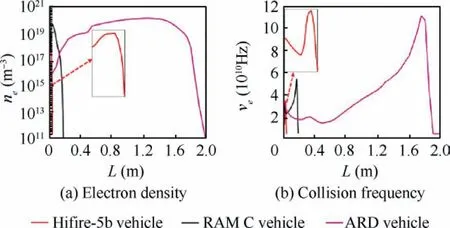
Fig.9 Distribution of electron density and collision frequency on terahertz wave transmission path.
4.2.Terahertz transmission characteristics under different vehicles
According to the analysis results of the plasma sheath data in Section 4.1, the plasma cutoff frequencies corresponding to maximum electron density in the transmission paths of different vehicle antenna positions (13.2 GHz for HIFIRE-5b vehicle,55.4 GHz for RAM C vehicle,97.2 GHz for ARD vehicle)are all smaller than the terahertz wave band.When the EMW frequency is greater than the plasma cutoff frequency, the absorption of the EMW by the collision between neutral particles and electrons makes a major contribution to the signal loss, and the reflection effect of plasma medium on the EMW is a secondary contribution.Therefore, transmission,reflection and absorption of terahertz waves in plasma sheaths enveloping different reentry vehicles are analyzed and discussed through terahertz transmission model.
Fig.10 compares the transmission, reflection and absorption of terahertz waves under HIFIRE-5b, RAM C and ARD vehicles, and the terahertz frequency concerned in this paper is 0.1–1 THz.According to Figs.10(a) and (c), at the same terahertz frequency, the transmission coefficient of HIFIRE-5b vehicle is the highest, RAM C vehicle is the second, and the ARD vehicle is the lowest.The variation of the absorption coefficient of the three vehicles is opposite to the transmission coefficient.It is obvious that the HIFIRE-5b vehicle will not experience RF blackout in all terahertz bands,while RAM C and ARD vehicles require terahertz frequencies to reach high enough values.
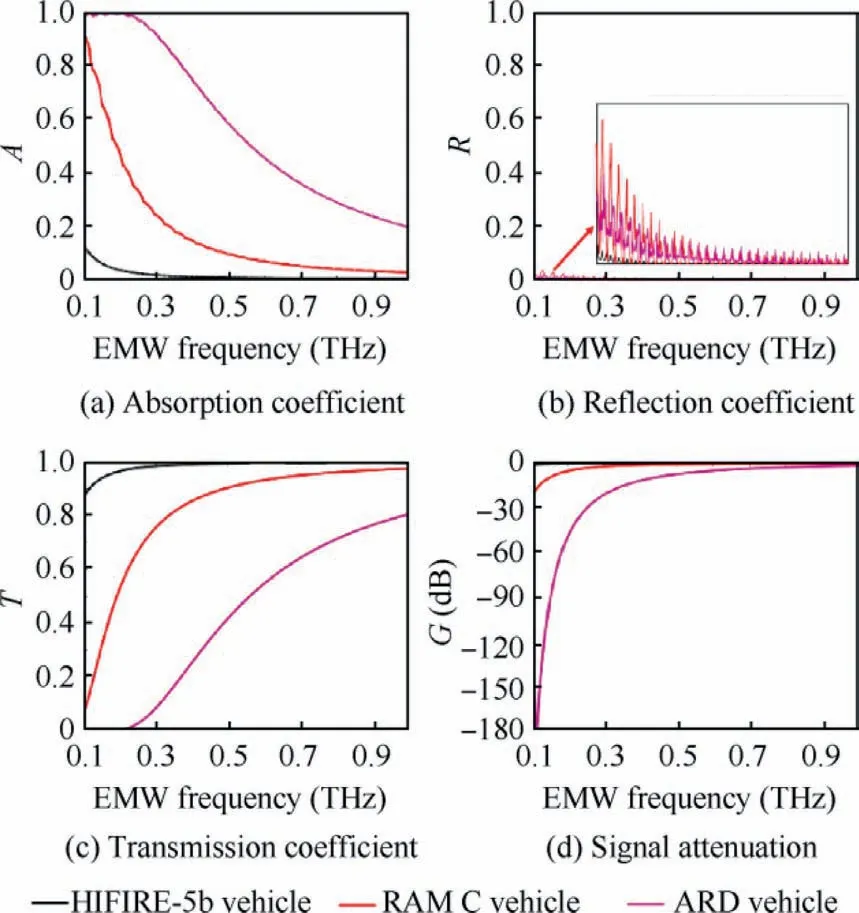
Fig.10 Absorption, reflection, transmission coefficients and signal attenuation of terahertz wave in plasma transmission path under different vehicle shapes.
In order to determine the critical terahertz frequency required for the three vehicles to maintain normal communication,Fig.10(d)shows the signal attenuation values at different terahertz frequencies.Generally,RF blackout is considered to occur when the signal attenuates below -5 dB.According to Fig.10(d), the terahertz critical frequencies suitable for HIFIRE-5b, RAM C and ARD vehicles communication are 0.1 THz, 0.21 THz and 0.57 THz, respectively.
There is little difference in THz wave reflection coefficients among the three vehicles(Fig.10(b)).However,compared with HIFIRE-5b and RAM C vehicles,the higher absorption of terahertz waves(Fig.10(a))by the ARD vehicle results in a lower transmission (Fig.10(c)).Therefore, the differences in the terahertz transmission characteristics under different vehicles are mainly caused by collision absorption, and the reason is that the plasma sheath thickness,electron density and collision frequency have significant differences under different vehicles.Relevant mechanism for difference in transmission coefficients of different vehicles due to collision absorption will be discussed further in the next section.
4.3.Mechanism of differences in terahertz wave propagation under different vehicles
Generally, the absorption effect of the plasma on the EMW will not exist when there is no collision in plasma.Fig.11 compares the terahertz wave transmission and reflection coefficients of three vehicles with and without collision.According to Figs.11(a) and (c), the transmission coefficients of HIFIRE-5b and RAM C vehicles are infinitely close to 1 when the plasma has no collision absorption,which means that there is no loss of terahertz waves at this time.Therefore, the terahertz transmission for HIFIRE-5b and RAM C vehicles is dominated by collision absorption, and the reflection effect does not exist.
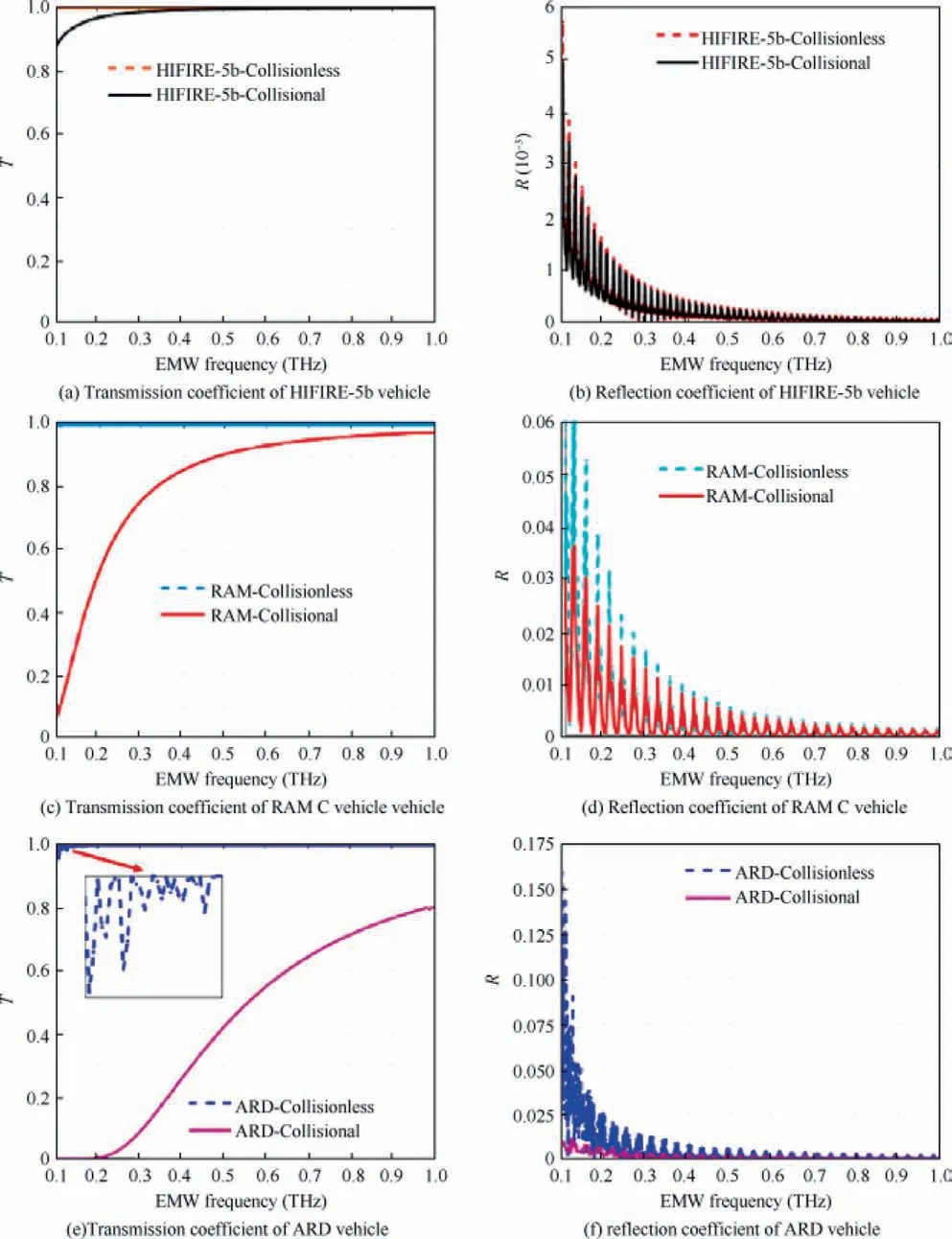
Fig.11 Comparison of terahertz wave transmission and reflection coefficients with and without collision for HIFIRE-5b,RAM C and ARD vehicles.
However, when the terahertz frequency is less than 0.18 THz, the terahertz wave transmission coefficient for ARD vehicle is not approximately equal to 1 despite the absence of collision absorption, as shown in Fig.11(e).At this time,the plasma sheath still has a certain loss for the terahertz wave,and this loss is caused by the reflection effect of plasma on the terahertz wave.Fig.11(f) provides evidence for this mechanism.The terahertz attenuation of HIFIRE-5b and RAM C vehicles are almost caused by the collision absorption effect,and the reflection effect can be ignored.For the terahertz attenuation of ARD vehicle,in addition to the main contribution of collision absorption, reflection effects also play a role.The reason for this reflection contribution is deduced to be the relative permittivity gradient caused by the spatial structure of plasma sheath.22
Based on the above analysis, it is obvious that the differences in terahertz communication around HIFIRE-5b, RAM C and ARD vehicles are mainly caused by the differences in the characteristics and spatial structure of reentry plasma sheath.Since the flight parameters and flight environment set by the three vehicles are the same, the differences in the characteristics and spatial structure of the plasma sheath mainly come from the differences in the shape of the head and tail of the vehicle.And by comparing the shape structures of three vehicles in Fig.1,it is found that the HIFIRE-5b vehicle has a smaller head and tail than the RAM C and ARD vehicles,and the terahertz wave transmission attenuation in the plasma sheath around HIFIRE-5b vehicle is smaller.Therefore, we preliminarily infer that smaller vehicle head and tail may lead to a lower terahertz wave attenuation in reentry plasma sheath.In order to verify the conclusion and explore the shape design scheme of future hypersonic vehicle for the blackout problem,the impact of the head and tail of vehicle on the plasma sheath and terahertz communication is further studied in the next section.
4.4.Analysis and verification of shape design scheme of hypersonic vehicle for blackout problem
In this section, RAM C vehicle is selected as the optimized vehicle object.The reason is that the size of the head and tail of RAM C vehicle are moderate,which is easier to change the size of head and tail to explore the relevant influence laws.Four vehicles with different shapes are formed by increasing and decreasing the size of the head and tail of the RAM C vehicle, which aims to further investigate the impact of head and tail of vehicle on the terahertz communication in reentry plasma sheath.The shapes and structures of the four types of vehicles are shown in Figs.12(a)-(d), corresponding to the larger head radius, smaller head radius, larger tail,and smaller tail compared with the standard RAM C vehicle,respectively.
Figs.13 and 14 compare the electron density and collision frequency distribution of four vehicles with different heads and tails and standard RAM C vehicle, respectively.Obviously, the changes in the head and tail of the vehicle all lead to significant changes in the spatial distribution of the plasma sheath.With the increase of the radius of the aircraft head,the plasma sheath thickness (Figs.13(a)-(c)), maximum electron density (Figs.13(a)-(c)) and maximum collision frequency(Figs.14(a)-(c)) all increase significantly.But for the increase in the tail of the vehicle, only a significant decrease in the plasma sheath thickness is observed, and the maximum electron density and maximum collision frequency have no significant changes.Through the above intuitive comparison of the plasma sheath distribution at the head and tail of vehicle, it can be found that the head of vehicle has a more significant influence on the spatial structure and characteristics of plasma sheath than tail of vehicle.
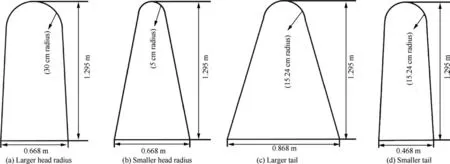
Fig.12 Four vehicles with different heads and tails compared with standard RAM C vehicle.

Fig.13 Electron density distribution of four vehicles with different heads and tails and standard RAM C vehicle.

Fig.14 Collision frequency distribution of four vehicles with different heads and tails and standard RAM C vehicle.

Fig.15 Comparison of electron density and collision frequency on terahertz wave transmission path for four vehicles with different heads and tails with standard RAM C vehicle.
Fig.15 further compares the specific values of electron density and collision frequency along the propagation path of terahertz antenna, and the antenna position is set to the middle position of vehicle (y = - 0.6475 m), as shown in Fig.13(a).Compared to the standard RAM C vehicle,the larger vehicle head radius has a larger plasma sheath thickness, lower electron density (which differs from the maximum electron density change visually observed in Fig.13), and higher collision frequency on the terahertz wave propagation path.When the vehicle head radius increases from 5 cm to 30 cm, the plasma sheath thickness increases from 9 cm to 33 cm,the electron density decreases from 7.61×1019m-3to 3.2×1019m-3,and the collision frequency increases from 67.9 GHz to 72.4 GHz.Significantly different from the effects of vehicle head, the wider vehicle tail results in a smaller plasma sheath thickness, greater electron density and collision frequency.When the vehicle tail width increases from 0.468 m to 0.868 m, the plasma sheath thickness decreases from 24 cm to 15 cm, the electron density increases from 2.33 × 1019m-3to 7.54 × 1019m-3, and the collision frequency increases from 53.7 GHz to 61.9 GHz.The specific values of plasma sheath thickness, maximum electron density and maximum collision frequency of various vehicles with different heads and tails on the terahertz wave transmission path can be found in Table 3.
Electron density, collision frequency and plasma sheath thickness have been proved theoretically and experimentally to be the three main factors affecting the electromagnetic wave transmission in the plasma sheath, and the electromagnetic wave attenuation increases with the electron density and the plasma sheath thickness, but is not monotonically affected by the collision frequency.33–35Although the increase of the vehicle head radius reduces the electron density, both the plasma sheath thickness and collision frequency increase.This effect makes it impossible to directly judge the impact of the vehicle head on the terahertz communication based on the effect of the vehicle head on the plasma sheath, which is also the same for the effect of vehicle tail width.Therefore,it is necessary to further calculate the terahertz transmission characteristics for these vehicles with different heads and tails.
Fig.16 compares the terahertz transmission characteristics in the reentry plasma sheath under various vehicles with different heads and tails.Compared with the standard RAM C vehicle, the smaller head radius and smaller tail of vehicle have a higher terahertz transmission coefficient (Fig.16(a)), corresponding to lower signal attenuation (Fig.16(b)).When the communication frequency is 0.1 THz, the corresponding terahertz wave attenuation of larger head vehicle, smaller head vehicle,standard RAM C vehicle,larger tail vehicle and smaller tail vehicle are -48.3 dB, -20.6 dB, -25.1 dB, -68.1 dB and -14.3 dB, respectively.When the vehicle head radius decreases from 30 cm to 5 cm, the critical frequency of terahertz wave communication reduces from 0.3 THz to 0.19 THz.When the vehicle tail decreases from 0.868 m to 0.468 m, the critical frequency of terahertz wave communication reduces from 0.35 THz to 0.17 THz.The phenomenonin Fig.16 verifies the conclusion that the smaller vehicle head and tail will lead to a lower terahertz wave attenuation in Section 4.3.

Table 3 Specific values of plasma sheath thickness, maximum electron density and maximum collision frequency.
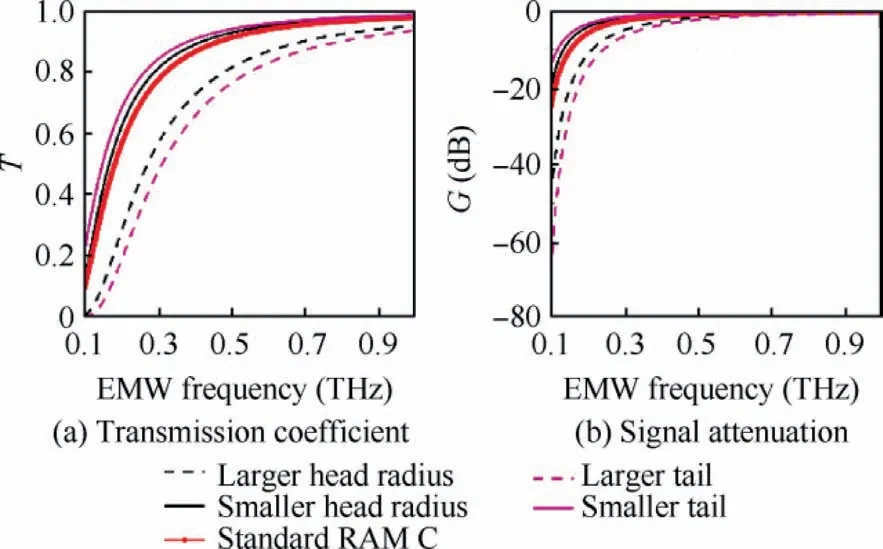
Fig.16 Transmission coefficient and signal attenuation of terahertz wave on plasma transmission path for vehicles with different heads and tails.
In addition, the contribution degree of reflection effects to terahertz attenuation due to changes in the spatial structure of plasma sheath is observed in Fig.17.As in the analysis of the difference mechanism of terahertz transmission characteristics of HIFIRE-5b, RAM C and ARD in Section 4.3,although the collision absorption plays a major role in the attenuation of the terahertz wave of the vehicle,only the reflection effect contribution is observed in the ARD vehicle.We infer that this is due to the more complex spatial structure changes of the ARD vehicle (the thicker plasma sheath leads to a more pronounced change in the plasma relative permittivity), and the effects of different vehicle head and tail on the plasma sheath properties (Figs.13 and 14) and terahertz reflection coefficients (Fig.17) also prove it.The plasma sheath thickness (Table 3) and spatial structure variation(Figs.13(a)-(c)) of the vehicle with larger head radius is much larger than that of the vehicle with smaller head radius and standard RAM C, so a significant increase in the THz reflection coefficient in the vehicle with larger head radius is observed in Fig.17(a) (enhanced reflection effect contribution).However, the influence of the vehicle tail on the thickness (Table 3) and spatial structure (Figs.13(c)-(e)) of the plasma sheath is smaller than that of the vehicle head(Figs.13(a)-(c)), which also leads to a small difference in the THz reflection coefficients of the standard RAM C vehicle,larger tail vehicle and smaller tail vehicle (Fig.17(b)).

Fig.17 Reflection coefficient of THz wave on plasma transmission path for vehicles with different heads (a) and different tails(b).
The above analysis proves that the shape design scheme of reducing the vehicle head and tail can effectively alleviate the communication blackout during hypersonic vehicle reentry,and lower the terahertz critical frequency needed to maintain normal communication.In addition,contribution mechanisms of reflection effect and absorption collision effect to terahertz attenuation under different aircraft shapes are also analyzed and demonstrated.Compared with HIFIRE-5b and ARD vehicles, the contribution of reflection effect to terahertz wave attenuation is only observed in ARD vehicle due to the thicker plasma sheath thickness and spatial structure change of ARD vehicle.
5.Conclusions
In this paper, a multiphysics coupling model combined with hypersonic plasma flow model under thermochemical nonequilibrium state and terahertz transmission model,is employed to study the difference in the terahertz wave propagation in thermochemical nonequilibrium plasma sheath under different hypersonic vehicle shapes, which aims to explore the shape design scheme of future hypersonic vehicle for the blackout problem.
Firstly, strong thermochemical nonequilibrium phenomenon under hypersonic flow is observed and discussed,and the calculation results of flow field are verified by comparison with the flight experimental data and grid-independent analysis.Then the terahertz transmission characteristics under HIFIRE-5b, RAM C, and ARD vehicles are compared and analyzed, regardless of plasma sheath thickness, electron density or collision frequency, ARD vehicle is much higher than RAM C and HIFIRE-5b vehicles, and the above differences in plasma sheath properties lead to more severe terahertz wave attenuation for ARD vehicle.By analyzing the influence mechanism of difference in reflection effects and collision absorption under three vehicles on terahertz attenuation, it is found that for the ARD vehicle, both the collision absorption and reflection effects make a certain contribution to the terahertz wave transmission, while for the RAM C and HIFIRE-5b vehicles, the reflection effect is almost non-existent.And it is inferred that this is due to the larger plasma sheath thickness and spatial structure change of ARD vehicle.In addition,through the analysis of difference in vehicle shape and terahertz transmission of HIFIRE-5b, RAM C, ARD vehicles, it is concluded that smaller vehicle head and tail may lead to a lower terahertz wave attenuation in reentry plasma sheath.
More importantly,the shape design scheme of reducing the vehicle head and tail can effectively alleviate the communication blackout during hypersonic vehicle reentry and contribution mechanisms of reflection effect have been proved by analyzing the effects of different vehicle heads and tails on the plasma sheath and terahertz communication.Conclusions in this paper are of great significance for the interaction between electromagnetic waves and the reentry plasma sheath,and the shape design scheme of future hypersonic vehicle for the blackout problem.
Declaration of Competing Interest
The authors declare that they have no known competing financial interests or personal relationships that could have appeared to influence the work reported in this paper.
Acknowledgements
This work was supported by the Joint Laboratory of Plasma Application Technology Funding, China (No.JL06120001H), and the Key R & D Plan of Anhui Province,China(No.201904a07020013).
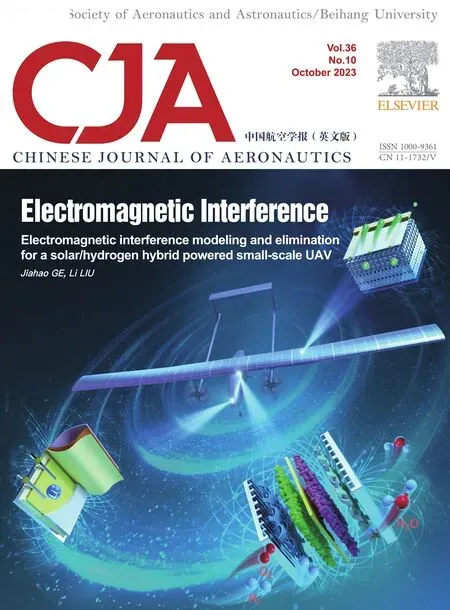 CHINESE JOURNAL OF AERONAUTICS2023年10期
CHINESE JOURNAL OF AERONAUTICS2023年10期
- CHINESE JOURNAL OF AERONAUTICS的其它文章
- Experimental investigation of typical surface treatment effect on velocity fluctuations in turbulent flow around an airfoil
- Oscillation quenching and physical explanation on freeplay-based aeroelastic airfoil in transonic viscous flow
- Flight control of a flying wing aircraft based on circulation control using synthetic jet actuators
- A parametric design method of nanosatellite close-range formation for on-orbit target inspection
- Bandgap formation and low-frequency structural vibration suppression for stiffened plate-type metastructure with general boundary conditions
- Geometrically compatible integrated design method for conformal rotor and nacelle of distributed propulsion tilt-wing UAV
